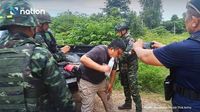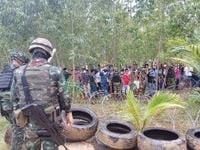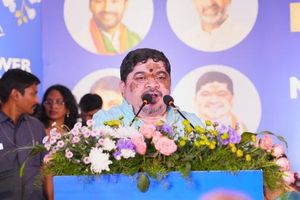Border tensions between Thailand and Cambodia have once again erupted into violence, as a series of clashes along their disputed frontier threaten to unravel a fragile peace painstakingly brokered just months ago. On September 17, 2025, Thai security forces and Cambodian civilians faced off near Prey Chan village in Cambodia’s Banteay Meanchey province—an area known as Ban Nong Ya Kaew in Thailand’s Sa Kaeo province—resulting in dozens of injuries and a new round of diplomatic brinkmanship.
According to Cambodian official statements reported by the Associated Press, at least 28 people were injured during several hours of confrontation. Thai authorities, meanwhile, confirmed that five of their soldiers were hurt, while a separate report from Reuters cited at least 23 Cambodian injuries. The violence marked the most significant escalation along the border since a deadly five-day conflict in July, which left at least 48 dead and displaced over 260,000 people before a ceasefire was hammered out with the help of Malaysia’s Prime Minister and pressure from U.S. President Donald Trump.
Wednesday’s melee began when Cambodian villagers attempted to tear down barbed wire fencing recently erected by Thai forces. Thai riot police responded with tear gas and rubber bullets in two separate incidents at 4:20 p.m. and 5:00 p.m., according to Khaosod English. The scene quickly descended into chaos as protesters threw rocks, sticks, and even fired slingshots, leaving two Thai police officers with head wounds. In response, Thai authorities deployed Long Range Acoustic Devices (LRADs)—machines that emit painfully loud, high-pitched sounds for crowd control.
Major General Winthai Suvaree, a spokesperson for the Thai Army, described the situation as a deliberate provocation. “This is clearly Thai sovereign territory, not disputed land or Cambodian territory,” he insisted, accusing Cambodian authorities of using civilians to violate the ceasefire agreement. He further explained that about 200 people crossed from the Cambodian side to protest the Thai deployment of barriers and concertina wire, escalating the situation into violence. “Thai authorities regarded the incident as a provocation and an intentional violation of the ceasefire agreement,” Winthai said, as reported by the Associated Press.
Cambodian officials, however, painted a starkly different picture. In a statement quoted by Khmer Times, Cambodia’s Information Minister Neth Pheaktra accused Thai forces of firing live ammunition, rubber bullets, and smoke bombs, as well as using high-frequency sound devices that can “damage the eardrum and brain.” The statement asserted that “Thai authorities fired live ammunition, rubber bullets, and smoke bombs at them, while also deploying high-frequency sound devices,” resulting in at least 28 injuries, including monks who fainted during the chaos.
The roots of this border dispute stretch back over a century. The contested areas were first mapped by France in 1907, when Cambodia was under colonial rule. The International Court of Justice (ICJ) in 1962 awarded sovereignty over the Preah Vihear temple area to Cambodia, but Thailand has long disputed the ruling. Despite the ICJ reaffirming its judgment in subsequent years, the issue remains a potent source of nationalist sentiment on both sides. In June 2025, Cambodia proposed returning to the international court to resolve the matter, but Thailand flatly rejected the idea.
Wednesday’s violence was not an isolated incident. It followed a similar confrontation on September 16, when Thai security forces again used tear gas and rubber bullets to restrain Cambodian crowds seeking to remove Thai defensive barriers. The border has been a flashpoint for weeks, with Thai authorities erecting new barbed wire fences in August and civilians from both countries staging regular protests. The Reuters report noted that the Thai military described their use of force as a response to “provocation from some 200 Cambodian protesters,” some of whom threw sticks and stones and fired slingshots at Thai officials.
The situation has prompted high-level diplomatic efforts. Malaysian observer Brigadier General Samsul Rizal Bin Musa visited the flashpoint area, though he clarified he was not there to settle territorial disputes. Instead, he urged patience as both sides prepare for upcoming Joint Boundary Commission talks. Meanwhile, Sa Kaeo Governor Prinya Photisart met with his Cambodian counterpart, Um Reatrey, at the Poipet-Klong Luek border crossing. Thailand presented several demands: civilians from both sides must stay at least 500 meters away from disputed areas, there should be no mass mobilization, and no military buildup with heavy weapons.
The most serious development came as Thai authorities issued a 30-day ultimatum: if the next General Border Committee meeting fails to produce an agreement, Thailand will formally demand that Cambodian residents withdraw from Ban Nong Jan and Ban Nong Ya Kaew, taking all property with them. Cambodia, for its part, was unable to immediately accept the ultimatum, citing the need for higher-level approval.
As night fell on September 17, the standoff showed no signs of abating. The 1st Army Region reported that about 200 Cambodian people and soldiers had established a base to monitor Thai actions in the disputed area, while Thai forces remained on high alert. Both sides continued to trade accusations of sovereignty violations and provocative actions. The Royal Thai Navy warned of escalation if Cambodia did not comply with a bilateral agreement requiring removal of structures and ditches in disputed areas in Trat province. Cambodia, meanwhile, insisted its residents in Ekpheap village, Pursat province, were legitimately residing on their own land and called for unresolved issues to be referred to the Joint Boundary Commission, in line with a 2000 memorandum of understanding.
Despite progress at the General Border Committee meeting earlier in September, the cycle of accusation and counter-accusation has only intensified. On September 13, a Cambodian military delegation led by Major General Chan Chopeatra entered the Chong An Ma area in Thailand’s Ubon Ratchathani province with over 50 armed soldiers—a move Thailand denounced as a ceasefire violation. Cambodia countered by accusing Thai soldiers of laying barbed wire on its territory and using tear gas against Cambodian citizens in Prey Chan village.
Amid the escalating rhetoric, analysts have urged both countries to rely on third-party arbitration. The Documentation Centre of Cambodia’s director, Youk Chhang, suggested that “the Thai military’s approach, which seems to be quick to defer to military responses, not only undermines the spirit of peace of the US-brokered agreement but is also another indication of the Thai military and government’s true and ultimate intentions, which is to secure its interests not through internationally recognised courts of law, diplomatic negotiations or other peaceful means, but by war.”
As the border remains tense and both armies dig in, the hopes for a durable peace may well hinge on whether cooler heads can prevail at the negotiating table—or whether the cycle of violence will spiral once more out of control.





